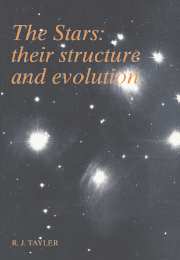Book contents
- Frontmatter
- Contents
- Preface
- Symbols
- Numerical values
- 1 Introduction
- 2 Observational properties of stars
- 3 The equations of stellar structure
- 4 The physics of stellar interiors
- 5 The structure of main sequence stars and pre-main-sequence evolution
- 6 Early post-main-sequence evolution and the ages of star clusters
- 7 Mass loss from stars
- 8 Close binary stars
- 9 Advanced evolutionary phases
- 10 The final stages of stellar evolution: white dwarfs, brown dwarfs, neutron stars and black holes
- 11 Concluding remarks
- Appendix 1 Thermodynamic equilibrium
- Appendix 2 The equation of radiative transfer
- Appendix 3 The pressure of a degenerate gas
- Suggestions for further reading
- Index
2 - Observational properties of stars
Published online by Cambridge University Press: 05 June 2012
- Frontmatter
- Contents
- Preface
- Symbols
- Numerical values
- 1 Introduction
- 2 Observational properties of stars
- 3 The equations of stellar structure
- 4 The physics of stellar interiors
- 5 The structure of main sequence stars and pre-main-sequence evolution
- 6 Early post-main-sequence evolution and the ages of star clusters
- 7 Mass loss from stars
- 8 Close binary stars
- 9 Advanced evolutionary phases
- 10 The final stages of stellar evolution: white dwarfs, brown dwarfs, neutron stars and black holes
- 11 Concluding remarks
- Appendix 1 Thermodynamic equilibrium
- Appendix 2 The equation of radiative transfer
- Appendix 3 The pressure of a degenerate gas
- Suggestions for further reading
- Index
Summary
Introduction
The subject matter of this book is stars and in particular the properties of individual stars but, before I start discussing these properties, I give a general description of the Universe in which the stars are situated and of which they may be the most important component. The may in this sentence be very important. At one time there would have been little doubt that stars are the most important constituent in the Universe. More recently it has become clear that there may be a considerable amount of material in the Universe which is not in the form of stars and it is possible that most of the mass in the Universe is in the form of weakly interacting elementary particles. In giving a brief description of the Universe, no attempt will be made to explain how the results are obtained, but subsequently a detailed discussion will be given of how the properties of stars are deduced from observation.
With the naked eye on a clear night one can observe a few thousand stars and it can be seen that there is a region in the sky, known as the Milky Way, in which there is a particularly large density of faint stars. With even a small telescope, the number of stars which can be seen is greatly increased and it is now known that the solar system belongs to a large flattened system of stars known as the Galaxy, which probably contains about 100000 million stars. Schematic views of the Galaxy as it would look from outside are shown in figs. 3 and 4.
- Type
- Chapter
- Information
- The StarsTheir Structure and Evolution, pp. 8 - 46Publisher: Cambridge University PressPrint publication year: 1994

